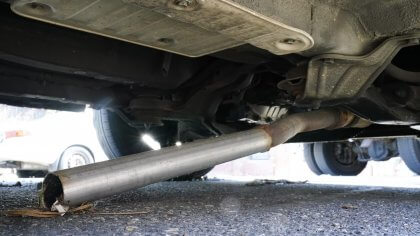“Cat” burglars
 By Steve Meloan —
By Steve Meloan —
The sound came in the dead of night – a brief, screeching metal-on-metal. It was all so alien to my half-asleep brain, I chalked it up to a catfight and soon drifted off again.
In the morning, my wife went out to run some errands. Starting the engine of her twenty-year-old Honda Accord parked at the curb, the whole car inexplicably shook with the low roar of a motorboat, a cloud of noxious exhaust rising up into the cab.
Welcome to the club of catalytic converter thefts. In today’s growing scavenger economy, where even street light poles are being stripped bare of valuable copper wire, theft of such exhaust emission control devices has reached epidemic proportions. According to the Sonoma County Sheriff’s Office, there have been 24 catalytic converters stolen in the city of Sonoma so far this year, and with certainly more to come.
Thanks to the precious metals of platinum, palladium, and rhodium contained within the converters, black market “Cats,” as they are called, can reportedly fetch anywhere from $100 to $1,500 at scrap yards. And then between parts and labor, it can cost $3,000 or more to get a vehicle back on the road.
According to CARFAX, the ten most targeted vehicles on the West Coast are the Toyota Prius, Ford F Series, Honda Accord, Ford Econoline, Chevrolet Silverado, Subaru Outback, Jeep Patriot, Honda Element, Subaru Forester, and Toyota Tacoma. The company further notes that catalytic converter thefts have skyrocketed in California – from 1,300 reported thefts in 2018, to more than 52,000 in 2021. That is a 1,215 percent increase.
Checking our porch security camera that next morning, it soon became clear this was no lone-wolf opportunistic crime, but a precision and well-oiled operation. The video footage was almost cinematic… the dead of night, crickets in the distance, then slowly approaching headlights. The first car circled past at 3 a.m., not even stopping, clearly testing for anyone being awake, or motion-activated lights. At 3:20 a.m., a different car approached, parking just across the street, a figure getting out and briefly checking our car. This was seemingly the final go/no-go drive-by. Ten minutes later, at 3:30 a.m., the original car returned, parking alongside our Honda. Two figures emerged with flashlights and equipment, clearly coordinated and moving purposefully. The actual screech of the electric saw only lasted five seconds – with almost surgical precision. Then they were back in their car with the Cat, switched off their headlights, and slowly drove away. Unfortunately, there was insufficient lighting to identify faces or license plates. According to the Sheriff who took our report, there was another car hit that same night, just a mile away.
Ironically, converters on older/larger cars tend to contain more of the desired precious metals, and are thus more valuable. In a spreadsheet provided by the Sonoma County Sheriff’s Office, most cars hit were in the 20-year-old range. But the Cats on such cars are also harder to find replacements for. As with many crimes, the most economically vulnerable are often the hardest hit. Someone with a decades-old car, a difficult to locate replacement converter, and a high insurance deductible might be left for weeks without access to their sole means of transportation, and then be faced with a repair bill of many thousands of dollars. For some older cars, the cost of repair can exceed the value of the vehicle itself—the insurance company potentially declaring it a “total loss.”
Suggested prevention measures include parking the car in a well-lit area (preferably a driveway or garage), having a vehicle ID number etched into the converter body, and a “Cat cage” – heavy-duty metal wiring surrounding the converter and bolted to the frame and engine block, increasing the time and complexity of removing the device.
With the more stringent environmental standards of California, any replacement converter must be approved by both the EPA and the California State Air Resources Board. After several weeks, our repair shop was finally able to locate a suitable Cat. But because of how ours was removed, it required additional parts beyond the actual converter, along with welding. And we’ve been told that with the spate of such thefts, converter guards/cages are now back-ordered by up to six months.



